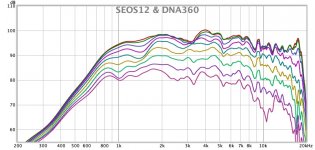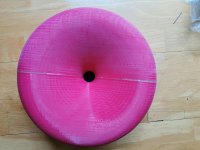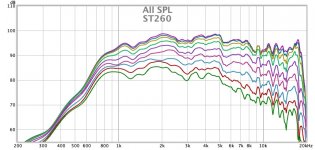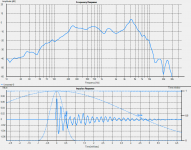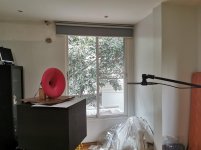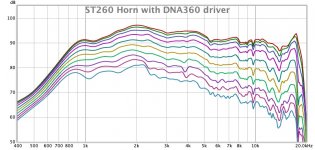Do you use some kind of a frequency-dependent window? It doesn't look like time gated or simply smoothed but it's not anechoic either. What did you change?
I gated the response at 4.6ms, no smooth using REW. The first time, REW did not ask for calibration time, I didn't know why. After shutdown and reboot, everything seems to work fine. My set up is not the best there are reflection from box that I set up driver for measurement.
Attachments
I recently completed a speaker that I suppose would fit here even though I didn't actually use Ath4 (I wrote my own tooling). The waveguide profile is OS with an angle- and curvature-matched Euler spiral (a.k.a. clothoid) termination starting at 40% of the total depth. Throat angle is 10°, which matches the compression driver I'm using (Celestion CDX1-1747). Here's the completed speaker: (snip snip snip)
This looks fantastic. Is the treble response equalised? Or you shaped the response in the crossover? Usually waveguides have a HF downward slope, as opposed to, say, JMLC horns on-axis.
Print quality is not so good. On the first half it was bend but the second half is good. I glue both together and fill the gap with epoxy
Here is the same driver with SEOS12 waveguide
Equalised?
I print ST260 waveguide and this is my measurement with Denovo audio DNA360 compression driver.
How long does it take to print one full waveguide (hence, I guess, two halves...)?
This looks fantastic. Is the treble response equalised? Or you shaped the response in the crossover? Usually waveguides have a HF downward slope, as opposed to, say, JMLC horns on-axis.
Thanks! Any constant directivity device will have a falling response. I implemented the crossover (including equalization) entirely in the digital domain with my DSP software. The drivers are connected directly to the power amps.
Because of the very high sensitivity in the upper midrange (at least 110dB/2.83V@1m; I haven't tried to measure this precisely), the system requires low noise DACs and amps in order to be free of audible hiss. I may decide to add a minimal passive crossover to the tweeter (like the JBL M2 does) at some point to mitigate this, but it's not a significant problem with my current electronics.
How long does it take to print one full waveguide (hence, I guess, two halves...)?
It took me 2 days for 1 waveguide. Off axis response is better than SEOS12 with the same driver.
I improve my measurement and get cleaner result. Here is gated response with 4.6mS no smoothing
Attachments
It took me 2 days for 1 waveguide. Off axis response is better than SEOS12 with the same driver.
I improve my measurement and get cleaner result. Here is gated response with 4.6mS no smoothing
Impressive! I want one!
I recently completed a speaker that I suppose would fit here even though I didn't actually use Ath4 (I wrote my own tooling). The waveguide profile is OS with an angle- and curvature-matched Euler spiral (a.k.a. clothoid) termination starting at 40% of the total depth. Throat angle is 10°, which matches the compression driver I'm using (Celestion CDX1-1747). Here's the completed speaker:
I applied the plaster in two coats, similar to two coat veneer plaster. The basecoat is about 3mm thick, cut 50/50 by weight with fine silica sand and the finish coat is 1mm neat. Here's the bare plaster waveguide. You can see the stainless rod in the middle:
This particular one was actually a failed attempt as the plaster didn't bond properly to the substrate. Due to the fact that gypsum plaster expands slightly as it sets, you need a bonding agent that provides some bond strength even when damp to prevent the plaster layer from lifting off the substrate near the waveguide mouth. For the attempt above, I sealed the MDF with a waterproof primer and then coated that with Elmer's Glue-All (a white PVA glue without water resistance). The problem is that the Glue-all turns back into a PVA emulsion on contact with the wet plaster and thus has no bond strength until dry. What I found works well is two coats type II water resistant PVA (I used Gorilla wood glue (NOT the polyurethane stuff), but Titebond II or any other similar product should work just as well), sanded lightly between coats, and one coat of Elmer's Glue-All. The Glue-All is probably not required, but I figured it would improve the bond once dry. Type II PVA adhesives get a bit soft when exposed to water, but don't completely re-emulsify. This property appears to be what makes it work so well for this application.
The gypsum cement I used is a G-P product called Densite (K-5, I think), which you can buy in small quantities at dickblick.com. USG Hydrocal White should also work well. Do not use USG Ultracal 30 or any other gypsum cement with portland cement (check the SDS). Based on my experience with Ultracal 30, it will shrink slightly over time and crack.
A suggestion for a building material....I think it would be hard to beat poly modified thinset mortar....its what I'm coving my speakers enclosures with...its basically cement that is sticky thanks to the latex in it...its also "flexible" thanks to the latex...its not really but relative to normal cement...yes...sticks to ply wood very well and I had to wack the sht out of a test board with a hammer to remove it off of plywood...one board I just gave up...because of its ability to contract and expand I don't believe that this product will crack....actually plaster of paris is known for cracking.
Thanks for the tip. I may try that in the future.
So far, I've had no cracking or adhesion problems with the gypsum cement I used. As you suggest, it's not very flexible, but I think the layer of PVA helps a bit with this a bit. It will crack if you whack it hard enough, but it's actually quite difficult to remove. I had to use an air hammer with a chisel bit to remove the plaster when I was doing prototypes.
So far, I've had no cracking or adhesion problems with the gypsum cement I used. As you suggest, it's not very flexible, but I think the layer of PVA helps a bit with this a bit. It will crack if you whack it hard enough, but it's actually quite difficult to remove. I had to use an air hammer with a chisel bit to remove the plaster when I was doing prototypes.
Hi,
I am printing the waveguide and it is going very slow. What compression drivers can anyone recommend on the frugal part of the price spectrum? Some of the drivers discussed on the other thread were on the hundreds of dollars/euros, more then my budget. I want to spend as little as possible and get the best value driver for this unit. My price range is from 50 usd to 125, less beeing better than more, but ultimately if the more suited will be the costlier within the price range, it would not be an issue. Some of the candidates, in no particular order, are the de250, cdx1-;1746, DFM-2544R00-08, n151m, CDX1-1425.
Tks
I am printing the waveguide and it is going very slow. What compression drivers can anyone recommend on the frugal part of the price spectrum? Some of the drivers discussed on the other thread were on the hundreds of dollars/euros, more then my budget. I want to spend as little as possible and get the best value driver for this unit. My price range is from 50 usd to 125, less beeing better than more, but ultimately if the more suited will be the costlier within the price range, it would not be an issue. Some of the candidates, in no particular order, are the de250, cdx1-;1746, DFM-2544R00-08, n151m, CDX1-1425.
Tks
Last edited:
- Home
- Loudspeakers
- Multi-Way
- Acoustic Horn Design - The Practical Way
